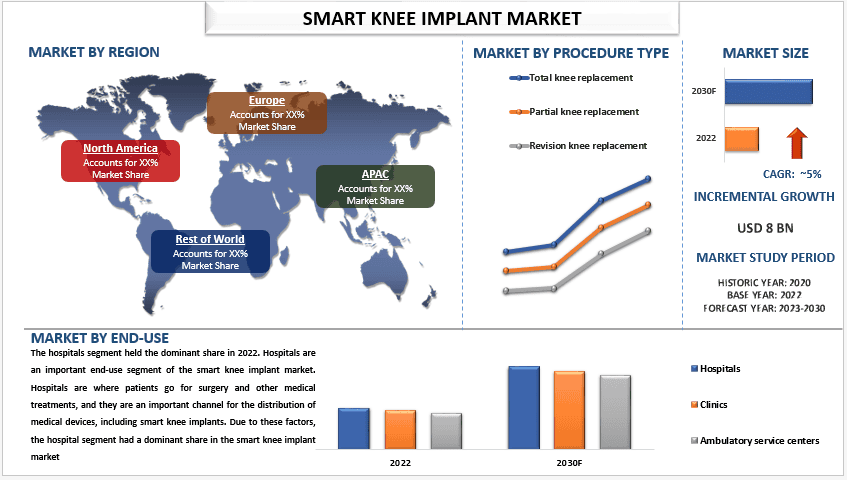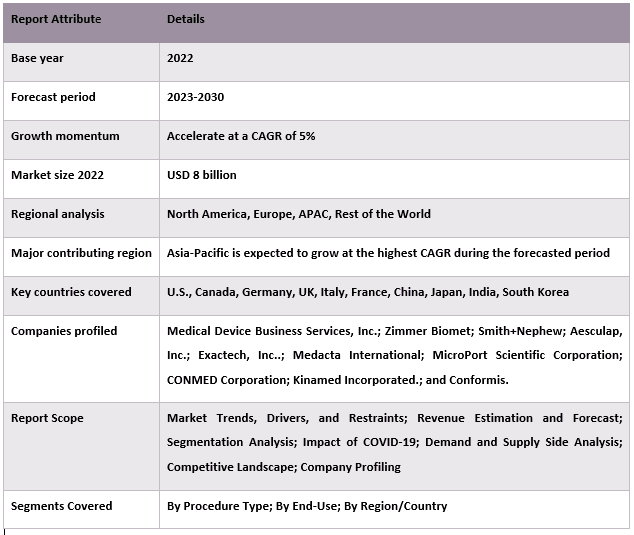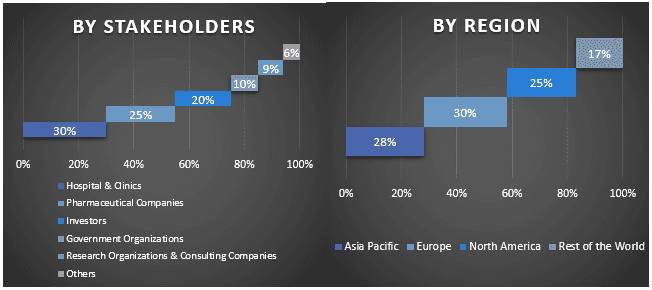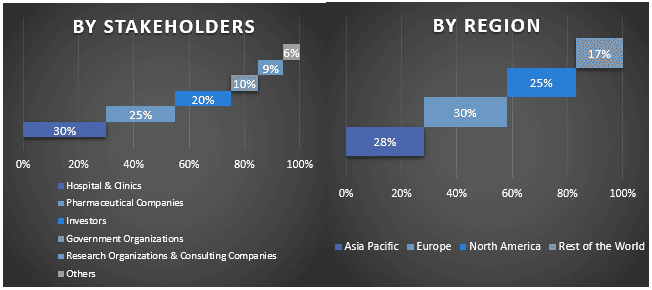Emphasis on Procedure Type (Total Knee Replacement, Partial Knee Replacement, and Revision Knee Replacement); End-Use (Hospitals, Clinics, and Ambulatory Service Centers); and Region/Country

The Smart Knee implant market held USD 8 billion in 2022 and is expected to grow at a strong CAGR of around 5% 5during the forecast period (2023-2030). A smart knee implant is an artificial knee joint that is designed to mimic the natural movement of a healthy knee. It is equipped with sensors and other technology that allows it to communicate with the surrounding environment and provide real-time feedback to healthcare providers. The market is driven by a number of factors, including the increasing incidence of knee-related disorders, advancements in technology, and rising awareness about the benefits of advanced implant technologies.
Some of the major players operating in the market are Medical Device Business Services, Inc.; Zimmer Biomet; Smith+Nephew; Aesculap, Inc.; Exactech, Inc..; Medacta International; MicroPort Scientific Corporation; CONMED Corporation; Kinamed Incorporated.; and Conformis. Several M&As along with partnerships have been undertaken by these players to facilitate customers with hi-tech and innovative products/technologies.
Insights Presented in the Report
“Amongst procedure type, the hybrid labs segment is expected to grow at a higher CAGR during the forecast period.”
Based on procedure type, the market is segmented into total knee replacement, partial knee replacement, and revision knee replacement. As per our analysis, the hybrid labs segment is expected to grow at a higher CAGR during the forecast period. Partial knee replacement is a significant application of the smart knee implant market, As the number of patients undergoing partial knee replacement surgeries increases, the demand for smart knee implants also increases.
“Amongst end-use, the peripheral vascular intervention segment held the dominant share in 2022.”
Based on the end-use, the market is segmented into hospitals, clinics, and ambulatory service centers. As per our analysis, the hospitals segment held the dominant share in 2022. Hospitals are an important end-use segment of the smart knee implant market. Hospitals are where patients go for surgery and other medical treatments, and they are an important channel for the distribution of medical devices, including smart knee implants. Due to these factors, the hospital segment had a dominant share in the smart knee implant market.
“Asia Pacific is expected to grow with the highest CAGR Smart Knee implant market during the forecast period.”
The Asia Pacific region is expected to be a significant market for smart knee implants in the coming years. The region is home to a large population of elderly individuals, who are more likely to suffer from knee-related disorders such as osteoarthritis. For instance, according to a report by the Technical Group on India and State Population Projections 2011-2036, by 2021 there will be nearly 138 million elderly people in India (67 million men and 71 million women). The number is expected to increase by about 56. 1 million in 2031.
Smart Knee implant Market Report Coverage

Reasons to buy this report:
Customization Options:
The global smart knee implant market can further be customized as per the requirement or any other market segment. Besides this, UMI understands that you may have your own business needs, hence feel free to connect with us to get a report that completely suits your requirements.
1. Market Introduction
2. Research Methodology Or Assumption
3. Market Key Insights
4. Executive Summary
5. Global Smart Knee Implant Market Covid-19 Impact
6. Global Smart Knee Implant Market Revenue, 2020-2030f
7. Market Insights By Procedure Type
8. Market Insights By End-use
9. Market Insights By Region
10. Smart Knee Implant Market Dynamics
11. Smart Knee Implant Market Opportunities
12. Smart Knee Implant Market Trends
13. Demand And Supply-side Analysis
14. Value Chain Analysis
15. Pricing Analysis
16. Strategic Insights
17. Competitive Scenario
18. Company Profiled
19. Disclaimer
Research Methodology for the Smart Knee Implant Market Analysis (2023-2030)
Analyzing the historical market, estimating the current market, and forecasting the future market of the global smart knee implant market were the three major steps undertaken to create and analyze the adoption of Smart Knee implant in major regions globally. Exhaustive secondary research was conducted to collect the historical market numbers and estimate the current market size. Secondly, to validate these insights, numerous findings and assumptions were taken into consideration. Moreover, exhaustive primary interviews were also conducted, with industry experts across the value chain of global smart knee implant market. Post assumption and validation of market numbers through primary interviews, we employed a top-down/bottom-up approach to forecasting the complete market size. Thereafter, market breakdown and data triangulation methods were adopted to estimate and analyze the market size of segments and sub-segments of the industry pertains to. Detailed methodology is explained below:
Analysis of Historical Market Size
Step 1: In-Depth Study of Secondary Sources:
Detail secondary study was conducted to obtain the historical market size of the smart knee implant market through company internal sources such as annual reports & financial statements, performance presentations, press releases, etc., and external sources including journals, news & articles, government publications, competitor publications, sector reports, third-party database, and other credible publications.
Step 2: Market Segmentation:
After obtaining the historical market size of the Smart Knee implant market, we conducted a detailed secondary analysis to gather historical market insights and share for different segments & sub-segments for major regions. Major segments are included in the report as procedure type and end-use. Further country-level analyses were conducted to evaluate the overall adoption of testing models in that region.
Step 3: Factor Analysis:
After acquiring the historical market size of different segments and sub-segments, we conducted a detailed factor analysis to estimate the current market size of the smart knee implant market. Further, we conducted factor analysis using dependent and independent variables such as procedure type and end-use of the smart knee implant market. A thorough analysis was conducted for demand and supply-side scenarios considering top partnerships, mergers and acquisitions, business expansion, and product launches in the smart knee implant market sector across the globe.
Current Market Size Estimate & Forecast
Current Market Sizing: Based on actionable insights from the above 3 steps, we arrived at the current market size, key players in the global smart knee implant market, and market shares of the segments. All the required percentage shares split, and market breakdowns were determined using the above-mentioned secondary approach and were verified through primary interviews.
Estimation & Forecasting: For market estimation and forecast, weights were assigned to different factors including drivers & trends, restraints, and opportunities available for the stakeholders. After analyzing these factors, relevant forecasting techniques i.e., the top-down/bottom-up approach were applied to arrive at the market forecast for 2030 for different segments and sub-segments across the major markets globally. The research methodology adopted to estimate the market size encompasses:
Market Size and Share Validation
Primary Research: In-depth interviews were conducted with the Key Opinion Leaders (KOLs) including Top Level Executives (CXO/VPs, Sales Head, Marketing Head, Operational Head, Regional Head, Country Head, etc.) across major regions. Primary research findings were then summarized, and statistical analysis was performed to prove the stated hypothesis. Inputs from primary research were consolidated with secondary findings, hence turning information into actionable insights.
Split of Primary Participants in Different Regions

Market Engineering
The data triangulation technique was employed to complete the overall market estimation and to arrive at precise statistical numbers for each segment and sub-segment of the global Smart Knee implant market. data was split into several segments & sub-segments post studying various parameters and trends in the areas of the procedure type and end-use in the global Smart Knee implant market.
The main objective of the Global Smart Knee implant Market Study
The current & future market trends of the global smart knee implant market were pinpointed in the study. Investors can gain strategic insights to base their discretion for investments on the qualitative and quantitative analysis performed in the study. Current and future market trends determined the overall attractiveness of the market at a regional level, providing a platform for the industrial participant to exploit the untapped market to benefit from a first-mover advantage. Other quantitative goals of the studies include:

Customers who bought this item also bought